#william k. everson
Text

W. C. Fields, January 29, 1880 – December 25, 1946.
12 notes
·
View notes
Text

Alex Gordon, Bela Lugosi, Lillian Lugosi, Richard Gordon, and film historian William K. Everson- 1953
15 notes
·
View notes
Text
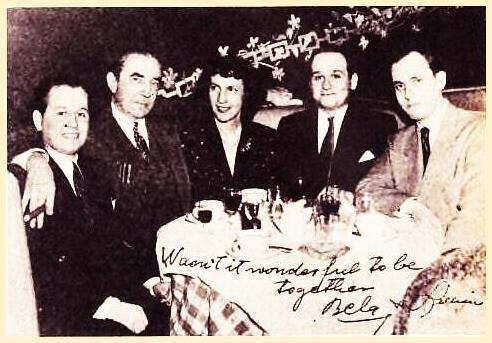
Alex Gordon, Bela Lugosi, Lillian Lugosi, Richard Gordon,and film historian William K. Everson, circa 1952.
5 notes
·
View notes
Text
The Old Dark House; a twice told tale.
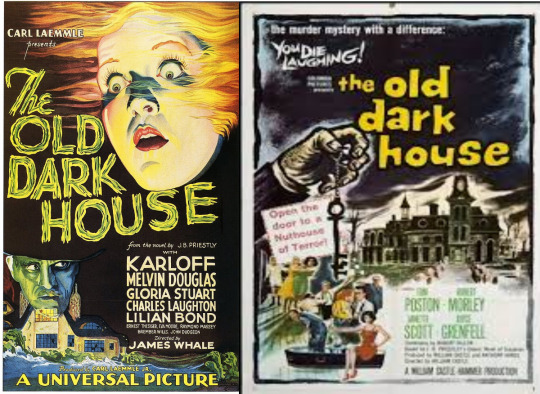
It was a dark and stormy night. Travelers find their car has developed problems and so they go to an old lonely house to seek shelter. In a stunning turn of events, nobody breaks into song, and there are no musical numbers. This isn’t after all, the Rocky Horror Picture Show, but “The Old Dark House” (1932), a pre-code Universal Horror film. In 1927, J.B Priestly (1894-1984)had a book published called “Benighted”. The book was a classic 'old dark house', which in films, had seen increasing popularity during the silent era, and has been referenced to this day in films like “The Rocky Horror Picture Show”, and Scooby Do cartoons. As popular as the old dark films were in the silent era, that popularity didn’t seem to carry into the sound era, and most of those made before WW2, were remakes of silent films, like “The Cat and the Canary”. One of these films that was not a remake was the 1932 “The Old Dark House”. Director James Whale saw some potential in the literary work “The Benighted”, and chose to make a film based on that book called “The Old Dark House”.
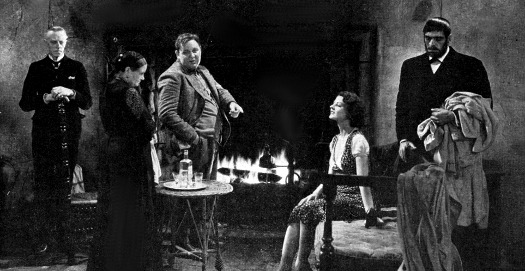
This was a film that Whale wanted to make, and he insisted Universal buy the film rights to the book. Whale selected the film's largely British cast, several of whose members were theater colleagues of his with minimal film experience, and would appear in several of his later films. These included Charles Laughton, Ernest Thesiger, and Boris Karloff. This may be the best performance from Thesiger, maybe even better then his performance as Dr. Pretorious in ‘Bride of Frankenstein”.

Although all nine of the New York daily papers gave the film positive reviews, many other publications gave it negative reviews. “Variety” calling it “Inane”. Initially, the film received good box office, but poor word of mouth saw box office receipts drop during the second week. The audience turn-out dropped to less than half in its second week and the film was pulled after ten days. In Britain the film did much better, even getting a re-release in 1939. Although not that popular in the United States, it did have a fan in Charles Addams. When his eccentric family made their very first appearance in 1938 in the New Yorker, The butler that would come to be known as Lurch, was clearly inspired by Karloff’s mad butler Morgan.

Universal would lose the rights to this movie in 1957, and it would be considered a lost film. A remake was released in 1963, directed by William Castle and co-produced with Hammer Films. Charles Addams would provide the title art for this movie, whose signature is painted by a hairy hand. That hairy hand (proto Thing?) and a very Charles Addams style Victorian house would be included in the poster art. Although the 1963 “The Old Dark House” is from the same source as the 1932 version, it is a very different film from the Whale film. This time, an American car salesman (Tom Poston) is asked to deliver a car by his roommate, to an old mansion on Dartmoor. In this case, In this version, a will requires that the members of a family descended form the pirate captain Morgan, are required to return to the dilapidated mansion before midnight each evening or forfeit his share of the family fortune. This story involves the different family members being bumped off one by one, while the Yank, bears witness to the strange proceedings.

The 1963 Old Dark House has developed a poor reputation, possibly in part, because of how it has been blamed for taking the place of the 1932 classic. William K Everson, author of “Classics of the Horror Film”, went so far as to call it a “practically blasphemous remake”. I get that. The 1932 film is a great classic film, and was nearly lost, but that wasn’t exactly the fault of the William Classic and Hammer remake. The fault is more that of Universal Studios, which allowed the film to become neglected. Director Curtis Harrington, a friend of James Whale, begged Universal to find the film, and it was located in 1968. It is easy to find now on DVD, or you can watch it for free on You Tube.
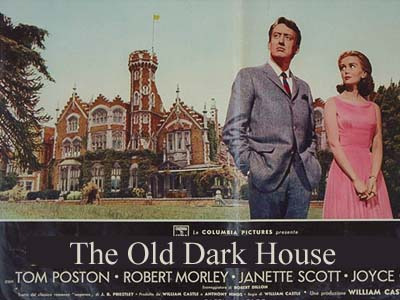
But is the 1963 film the “practically blasphemous remake” that Everson claimed? Of course not. Outside of the title, the two have almost nothing in common, and are different enough, you can watch one, without making comparison’s to the other. My first viewing of the 1963 film was on a 16 MM projector, being shown on a screen in my family’s back yard. I was very happy to see the Charles Addams opening, and I genuinely liked it, not being aware of the 1932 film, I was able to watch it without being troubled by the differences in the Hammer/Castle film, and the 1932 Whale classic. Catching it later on, I liked that the dilapidated mansion they used for the film was “Oakley Court”. If you have seen “The Rocky Horror Picture Show”, you would be familiar with the house. Being a Hammer co-production, it was in the vicinity of Hammer’s Bray studios, so it was used in a number of Hammer films.
I love both films enough to have them of DVD, and consider them both worth a watch.
#rocky horror picture show#Tom Poston#Charles Addams#Universal#Boris Karloff#Willaim Castle#James Whale#Hammer#the old dark house
6 notes
·
View notes
Text
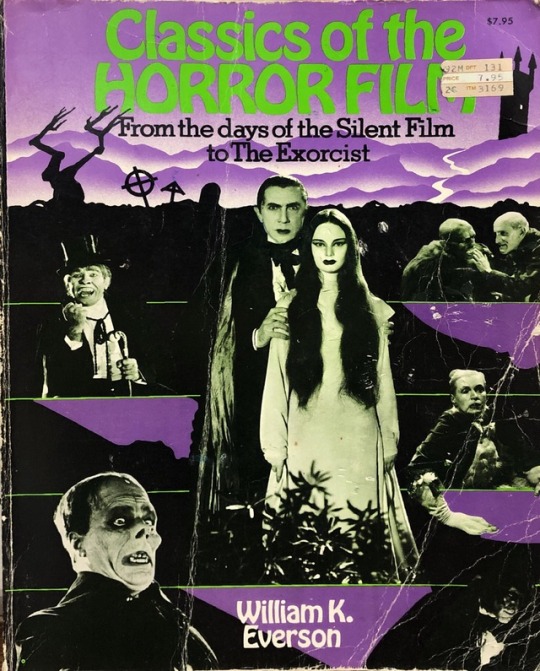

#classics of the horror film#william k. everson#monsters#horror#universal monsters#exorcist#psycho#dracula#hitchcock
191 notes
·
View notes
Text
Silent Movie Bookshelf: The Bad Guys, A Pictorial History of the Movie Villain by William K. Everson
Silent Movie Bookshelf: The Bad Guys, A Pictorial History of the Movie Villain by William K. Everson
Everybody loves a good villain and this book covers movie villains from the silent era through the 1960s. Best of all, it is written by William K. Everson, who was one of the most assertive defenders of silent movies during the mid-century dark age.
(more…)
View On WordPress
1 note
·
View note
Text
More “gems” from William K Everson
I really just want to finish American Silent Film at this point. Like... I have rarely been so annoyed with an academic work.
I’m reading the section on comedy and Everson is decribing Buster Keaton’s films as misogynist essentially, claiming his heroines are “stupid” and “useless,” and that his movies are full of “sour put-downs of women.”
Like... was he high when he wrote this?
Maybe it’s because I’m a woman who enjoys Keaton’s work, but I’ve never viewed his movies as sexist or “put-downs” against women in any way. His heroines are rarely stupid at all.... even Annabelle from The General isn’t so much an idiot as a southern belle put into a situation she’s just not suited for.
Also, I wouldn’t call the Girl in Sherlock Jr a fool, considering SHE SAVES BUSTER’S CHARACTER in the real world frame plot.
In The Navigator, Betsy and Rollo are on equal footing as far as incompetence goes, basically acting as comic partners.
At their worst, Keaton heroines didn’t do much but wait to be won, like in Seven Chances, where I barely recall the love interest at all . But even the ones who don’t act as comic partners, like in Steamboat Bill Jr, College, or Battling Butler, at least have some spunk and appeal-- they’re certainly not these grotesque, sour, stupid creations Everson is describing.
If Keaton is cynical about anything, it might be the happy ending ideal, as in College, where the epilogue has us questioning the “love and marriage” coda of most mainstream comedies of the time. But then again, Keaton is hardly a dour filmmaker.
Idk, Everson is just grating me at this point, between his weird dismissal of certain genres and directors, to his endless parade of “DW GRIFFITH WAS THE BEST AND IF ANY OTHER DIRECTOR IN THE SILENT ERA WAS ANY GOOD THEY WERE INSPIRED BY DW CUZ WHEN THERE’S TROUBLE YOU CALL DW OH YEAH.”
Rant over. Happy I only have one hundred pages left.
4 notes
·
View notes
Text
Bad Men and Good Acting
Bad Men and Good Acting
Rathbone with Olivia de Havilland in The Adventures of Robin Hood
In the 1930s Basil Rathbone played a series of villain roles so well that he was in danger of forever being typecast as a villain, and never being offered other roles. Film historian William K. Everson has called Rathbone “the best all-around villain the movies ever had.” In 1938 Bosley Crowther of the New York Timesinterviewed…
View On WordPress
4 notes
·
View notes
Photo

William K. Everson, April 8, 1929 – April 14, 1996.
12 notes
·
View notes
Text
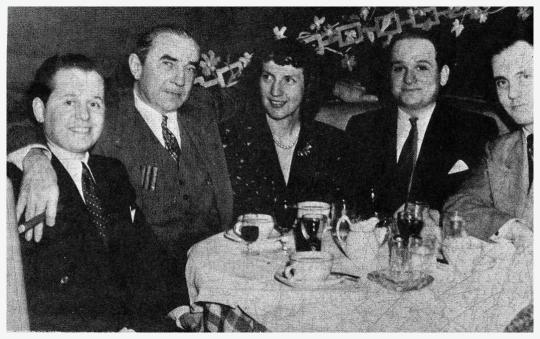
Alex Gordon, Bela and Lilian Lugosi, Richard Gordon, and film historian William K. Everson circa 1953.
1 note
·
View note
Photo

New Post has been published on http://www.classicfilmfreak.com/2018/10/18/the-old-dark-house-1932-starring-boris-karloff-charles-laughton-and-melvyn-douglas/
The Old Dark House (1932) starring Boris Karloff, Charles Laughton and Melvyn Douglas
If ever true, it’s true here: it’s “a dark and stormy night.” O-O-O-o-o-o—
It’s October. October is Halloween, and the best possible excuse to celebrate is to watch an old fright film. To begin things, what about a motor drive through a storm? How many horror films have thus started? Countless ones. So we arrive at this one house, knock on the door—there’s a cavernous echo from inside, of course—and we’re greeted by, hardly a lovely maid with a friendly smile, but by . . . well, it could be anyone from any number of movies and Gothic novels.
In this case—by some strange coincidence—we find ourselves in the plot of The Old Dark House. Which means we’re greeted, neither by the aforementioned young lady nor anybody as inviting, but by a bearded, wild-eyed man with an unintelligible mumble. Do we run in fear? Ask for our money back, change channels? . . .
(adsbygoogle = window.adsbygoogle || []).push();
No, as Alfred Hitchcock said so often, “It’s only a movie.” No, we stay and meet some of the old gang from the horrors, this particular gang anyway. After all, if the people we’ll meet—those already there and those who will arrive later, as uninvited guests always do in these films—if they aren’t part of any famous horror “gang,” like those from the Universal or RKO folks, then, to their credit or chagrin, they’ve appeared in at least one horror movie.
The few full-fledged horror society members in The Old Dark House who could be regarded as part of a “gang”—Boris Karloff, Ernest Thesiger and Gloria Stuart—have been assembled by their gang leader, that master of the macabre, Englishman James Whale. This is his second horror film. The year before, Frankenstein had begun his great trilogy in the genre that includes The Invisible Man (1933) and The Bride of Frankenstein (1935).
The Old Dark House falls just a bit short of being in this esteemed company, but it’s still fascinatingly suggestive of things to come. Critic William K. Everson wrote that it was better the second time and “is one of the real masterpieces of its genre.” In the film’s general milieu and the style of the sets, it’s obviously from Universal and from producer Carl Laemmle (Jr.). A horror gang member with undeniable credentials, he produced not only Whale’s great trio but also Dracula (1931), Murders in the Rue Morgue (1932), The Mummy (1932) and many other similar titles.
Cinematographer Arthur Edeson, though perhaps more versatile, with a wider scope of genres than either Whale or Laemmle, shooting such diverse films as The Maltese Falcon (1941) andCasablanca (1942), does occasionally turn his camera toward the strange and terrible—in The Invisible Man and Frankenstein. The Old Dark House contains some of his finest work.
In 1932, nearly all film scores were limited to opening and closing titles. But in 1933, coming from RKO and with practically continuous music by Max Steiner, King Kong was something of an exception to the rule, an aberration, even. Producers were still worried that audiences would wonder where the music was coming from. While ground-breaking by its mere premature appearance, Steiner’s music isn’t particularly original.
In The Old Dark House, the main title is by the obscure David Broekman. With no score heard again until the stock music of the end title, it’s assumed that the atmosphere, especially compared with the wall-to-wall scoring of later horror films, would be deprived of an essential support. True in most cases, but here, taking music’s place, is the sound of rain and thunder, rustling curtains, banging shutters, slamming doors, creaking stairs and footsteps on hard floors.
For the first thirty-five minutes or so, nothing untoward really happens—a lot of talking and those unsettling sounds. The screenplay, by Benn W. Levy, is based on Benighted by J. B. Priestley (not “Priestly” as listed in the credits), and additional dialogue is by R. C. Sherriff. Whether from Priestley or Sherriff, the lines are often kinky and satirical, some even nonsensical, with presumed influence from Mr. Whale.
These characters and their actor-re-creators combine to make a simple enough plot. There is an intentional pairing of the five weirdos of the household against the five strangers who, startlingly normal by contrast, show up to escape the pestilential rain.
But back to that fearsome man at the door. . . .
The Wavertons, man and wife, have driven through the storm in the Welsh countryside—Margaret (Stuart; her horror film credits include The Invisible Man and The Prisoner of Shark Island, 1936) and Philip (Raymond Massey, Arsenic and Old Lace, 1944). With them, in the back seat, is their friend, Roger Penderel (Melvyn Douglas).
They had knocked on the door and been greeted by the mumbling Morgan (Karloff). Now the head of the house, the quirky Horace Femm (the skeletal Thesiger, The Bride of Frankenstein, many more), comes to the door. Inside, the Wavertons meet Horace’s crabby sister Rebecca (Eva Moore), who will later tell Margaret that living with them is her aged father, Sir Roderick Femm (played by actress Elspeth Dudgeon, complete with beard!, and listed in the main title as John Dudgeon).
Then through the rainy night come two more travelers, Sir William Porterhouse (Charles Laughton, Island of Lost Souls, 1932, and The Strange Door, 1951) and his girlfriend Gladys DuCane (Lilian Bond).
A lot begins to happen after those first thirty-five minutes, which have set the stage and titillated the audience with anticipation. Roger romances Gladys, to Sir William’s indifference. Hearing a voice like a child’s, Margaret and Philip discover Roderick in bed. He warns them that an arsonist, his eldest son, Saul (Brember Wills), is locked in an upstairs room—overtones of the imprisoned wife in Charlotte Brontë’s Jane Eyre.
Morgan sets Saul loose. The clearly deranged Saul knocks Roger out and sets fire to a curtain. When Roger regains consciousness, the two fight and fall from a balcony. With Roger injured, Morgan tenderly cradles the dead Saul, then takes the body upstairs.
The storm finally over by morning, Gladys and Sir William tend to the injured Roger while Margaret and Philip drive off to find an ambulance. As the Wavertons leave, Horace sardonically bids them farewell: “Goodbye. Goodbye. Bye. Bye. Nice to have met you.” As if nothing has happened. When Roger awakens, he asks Gladys to marry him.
But what of that wandering, mumbling Morgan? And, oh—don’t forget!—Horace and his sister are still there, too, in this old dark house, perhaps ready to make mischief for any travelers who might—shall we say?—“foolishly” seek refuge from that next storm.
youtube
2 notes
·
View notes
Link
Intolerance on the other hand, excited the “intellectual” directors – George Pearson in England, Maurice Tourneur in America, Carl Dreyer in Denmark, Eisenstein in Russia, Raymond Bernard in France. With the war in progress, that influence was delayed in many cases for several years, and then (as in the case of Dreyer’s Leaves From Satan’s Book ) not seen by a large “popular” audience. But in America, one had a concrete example of the film’s impact on ( if not influence on ) routine commercial directors when Frank Lloyd’s A Tale of Two Cities (1917) based its attack on the Bastille very closely on Cyrus the Persian’s attack on Babylon, with many compositions and cuts duplicated completely. Apart from the influence of Intolerance on the many directors who worked on it as actors and assistant directors—W. S. Van Dyke, Elmer Clifton, Tod Browning, Lloyd Ingraham, and others—one may perhaps assume a certain input from Erich von Stroheim, who played a small role in the film and also acted as an assistant and a tenuous, nondefined kind of art director as well.
#silent#intolerance#Intolerance: Love's Struggle Throughout the Ages (1916)#book#william k everson#1978#DW Griffith#lillian gish#biography#review
1 note
·
View note
Photo

Alex Gordon,Bela Lugosi,Lillian Lugosi,Richard Gordon and William K. Everson-circa 1951
click to enlarge
17 notes
·
View notes